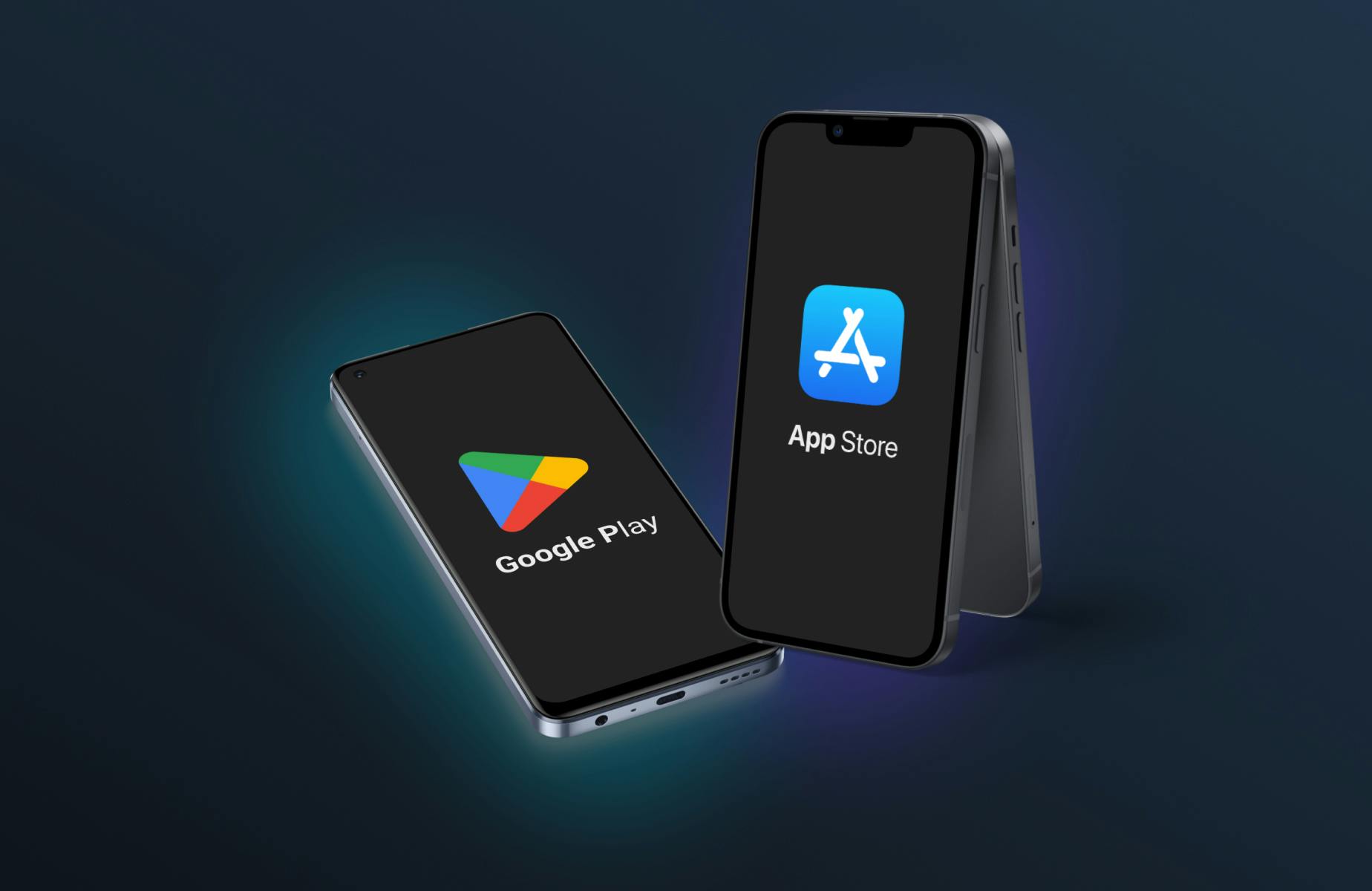Faced with choosing a tech stack for your application, you certainly take into account factors such as the capabilities of a given technology, scalability, efficiency, security, avoidance of technological debt, or the possibility of introducing artificial intelligence algorithms. You probably already have an idea about the most popular backend technologies, and .NET is no stranger to you. However, are you up to date with changes in this ecosystem?
In this article, we’ll dispel myths about .NET so you can better understand what this platform really offers. Check if you can tell the difference between myths and facts about C# .NET.
1. .NET is an outdated and heavy technology. | False!
This is a myth!
Absolute myth! .NET has nothing to do with being outdated, not to mention being heavy. .NET is an efficient and innovative platform, and its development is extremely dynamic. The advantage over its direct competitors such as Java, Python or Node.js is due to several key reasons:
Super speed
Each subsequent version of .NET breaks speed records in terms of performance. Let’s look at the chronology:
.NET 5
.NET 5 released in 2020 achieved an impressive advantage over competing solutions when it comes to creating the backend of web applications, being 10 times faster than Node.js and approximately 6 times faster than Java.
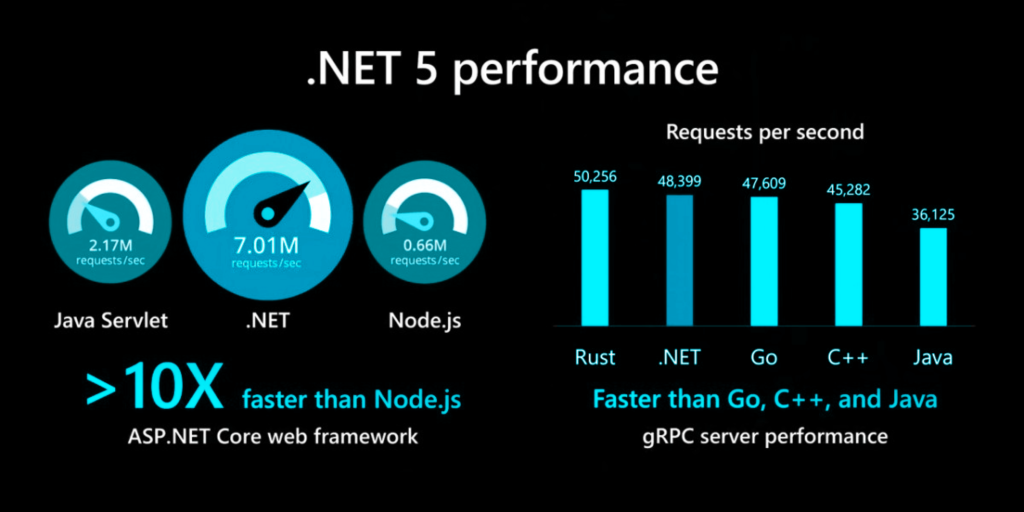
.NET 6
The next version was even more efficient. Entity Framework Core was able to handle as much as 92% more requests per second than .NET 5.
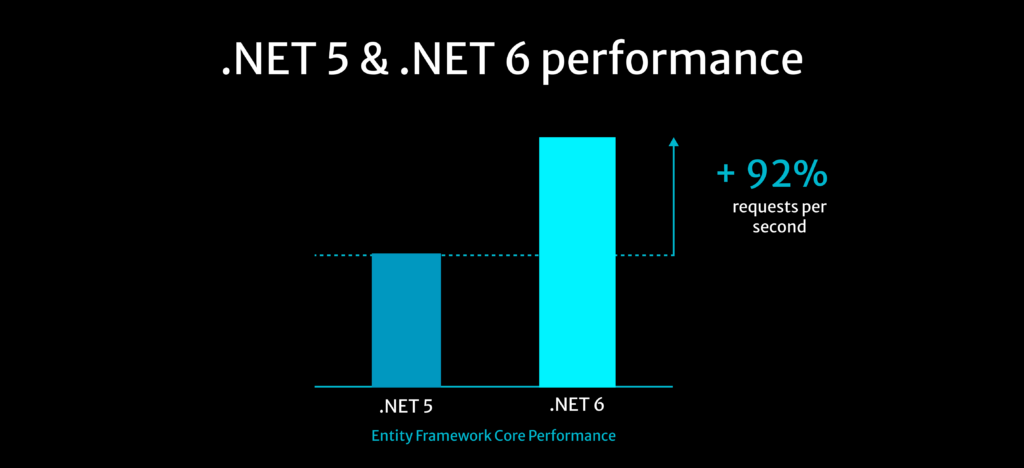
.NET 7
The biggest performance leap can be observed between .NET 6 and .NET 7. Some elements of the ASP.NET framework have been improved… 400x times. An example is the linQ library, which allows developers to filter large amounts of data in a short time
extracting a specific record from the database. It is one of the core .NET libraries, built into the platform. Nowadays, every web application uses linQ.
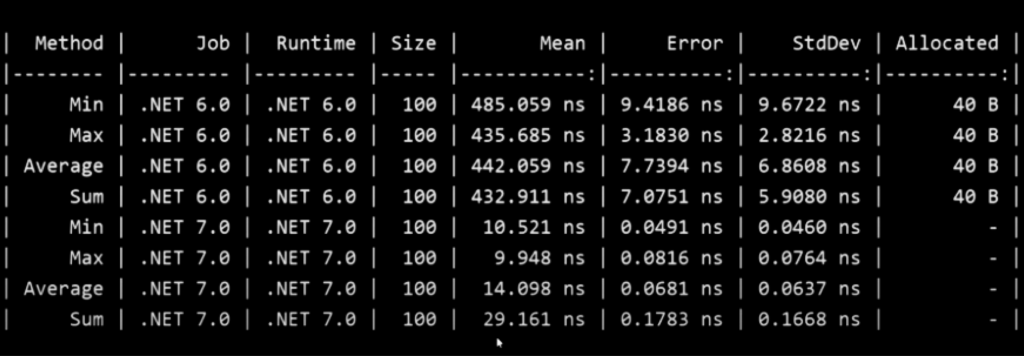
.NET 8
The November 2023 version achieves even greater speed compared to the previous version, which indicates a clear qualitative leap in this technology. Microsoft’s Stephen Toub, who annually publishes in-depth analysis of updates between .NET versions, calls .NET 8 “faster than super-fast.”
.NET still maintains its position as a strong and effective framework, competing with other technologies available on the market. In addition to improving performance, .NET is constantly expanding its capabilities in other directions. Examples could be:
- .NET Aspire – one of the latest tools that makes the implementation of microservices architecture almost as fast as a monolith. Microservice architecture has many advantages over monolith, especially for larger applications: it is faster, safer, and scales much better. So far, the downside of this solution has been its time-consuming nature and high requirements for programmers’ competencies. With .NET Aspire, you can significantly speed up and simplify the implementation of microservices.
- .NET MAUI – the evolution of Xamarin Forms, a framework for creating multiplatform applications thanks to one code base, including iOS, Android, macOS, Windows.
- Native AWS/Azure Cloud support – support for these cloud platforms is simple and hassle-free, since they are built directly into the development environments on which .NET applications are created. Previous integration often required the use of additional libraries, SDKs or tools created by external companies or the community.
- Blazor – which allows you to create front-end web applications in C# and .NET.
- ML.NET – an open and dynamically developed library of Machine Learning/AI algorithms
2. .NET is mainly used to create desktop applications for Windows. | False!
Let’s debunk this myth!
Many people associate .NET with desktop programs for Windows. Perhaps rightly so – .NET has its origins as Microsoft’s own, closed technology. This is now history, and .NET itself has undergone a number of changes.
In 2016, .NET became a cross-platform technology. With this change, .NET now runs on a variety of platforms, including even containerization-based environments. Containerization makes it easier to run .NET applications on any platform without having to adapt the application to each environment individually.
The areas in which .NET is most commonly used are: the backend of web applications, IoT solutions, and games. However, its capabilities are not limited only to these areas. In the current version of .NET you can write absolutely anything, including desktop applications for various platforms (Windows, Linux, Mac), programming interfaces (web APIs), and even front-end mobile and web applications.
Moreover, .NET strongly expands the possibilities of implementing artificial intelligence, opening new horizons for software developers.
At mobitouch, our focus within .NET is mainly on using its capabilities to create web applications. Check out how we use the possibilities of this ecosystem here.
3. It’s all about AI and Machine Learning now. You can’t do them in .NET, Python is the best choice. | False!
Let’s debunk this myth!
You can do virtually anything in .NET, including creating your own AI/ML algorithms. Ready-made and constantly developed libraries of these algorithms are available thanks to ML.NET.
Python may have a quantitative advantage in the number of libraries and a very low entry barrier (simple language, large number of AI/ML libraries), but Python’s great disadvantage is speed. The performance difference between .NET and Python is huge in favor of .NET. Writing the same AI algorithm in .NET currently takes longer than when using Python. However, once the code is written, it will work much more efficiently.
The AI revolution is not leaving out the .NET ecosystem and is also being strongly developed here. The emergence of AI/ML libraries, combined with the inherent speed of .NET, may make it a real threat to Python’s dominant position in this area.
An example of the use of Machine Learning in .NET can be seen in one of our projects, which involved sentiment analysis. It involves detecting user statements of a specific nature. It’s a better method than standard content filtering, as it can be trained to understand the full context of a statement, thus assessing its nature, rather than just detecting individual words. This is useful when automating user comment moderation in our app, preventing undesirable opinions like hate speech or vulgarities. Of course, this is just one of the myriad applications of artificial intelligence through .NET.
Thinking about creating an application, but not sure how to start? We’re here to help.
Let’s talk4. With .NET you’re limited to the paid Microsoft SQL Server. | False!
It’s a myth!
.NET opens the door to a variety of database solutions, allowing developers the freedom to use many different systems. Available options include popular databases such as MySQL, PostgreSQL, Oracle, as well as flexible NoSQL solutions like MongoDB. This diverse ecosystem enables developers to match the right tool to the specific needs of their projects. It’s noteworthy that most database technology providers actively support the .NET platform, significantly easing the integration process. .NET’s open approach to various database systems translates to flexibility in designing and developing applications, enabling the use of tools that best fit specific project requirements while not being limited to one particular database. This approach makes .NET an attractive option when seeking flexibility in database technology choices without being tied to a single provider.
5. .NET is a type of framework, so ”.NET” is simply a shorter name for “.NET Framework”. | False!
This is a myth!
The naming of different .NET versions can be confusing for those not dealing with it daily. When we say “dotnet”, we refer to the entire ecosystem of this platform, including its various versions.
It’s important to remember that .NET Framework is the oldest version, dating back to 2002, which was closely tied to the Windows environment. In 2019, Microsoft stopped supporting .NET Framework.
In 2016, .NET Core was introduced, which was a lightweight and open-source version of the framework. From that point on, it can also run on Linux and MacOS. .NET Core introduced modularity, enhancing .NET’s scalability and performance. This was a milestone in the platform’s development. Since then, new versions of .NET Core have been released. After the publication of .NET Core 3.1, the word “Core” was dropped from the name for simplicity. Current versions of .NET are identified by numbers, such as “.NET 6, .NET 7, .NET 8,” etc., even though they are still based on .NET Core.
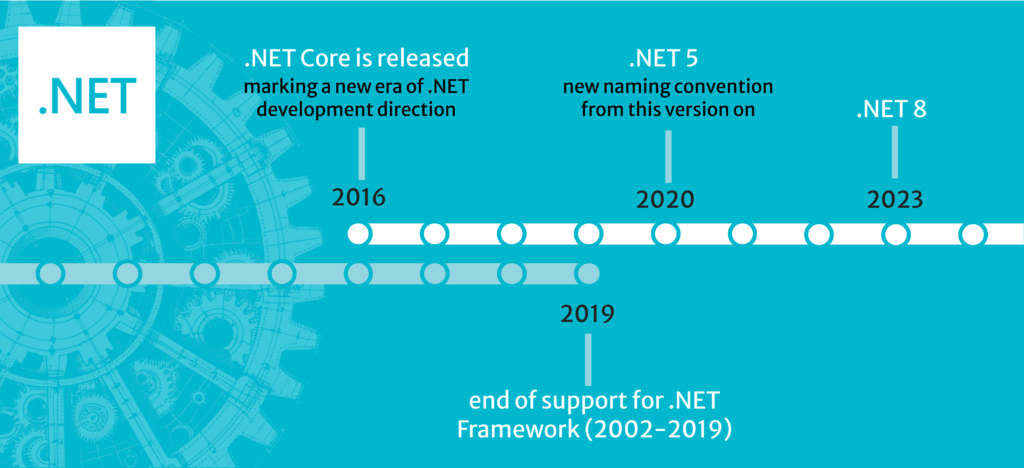
.NET Framework – old and unsupported version of .NET
.NET Core – the revolutionary successor to the .NET Framework.
.NET 8 – a specific version of .NET Core. In the case of .NET 8, this is the 2023 version.
6. ASP.NET is a niche technology from .NET. Now everything is done in .NET 8. | False!
This is a myth!
.NET is an entire ecosystem encompassing various types of applications such as desktop, mobile, gaming, IoT, and web applications.
ASP.NET is a part of the .NET ecosystem, designed for creating APIs that enable communication with the frontend. With new versions of dotnet, like .NET 8, ASP.NET is also being updated. It provides a set of tools and libraries specific to building web applications.
ASP.NET was officially released by Microsoft in January 2002 as a part of the .NET Framework 1.0 version. This technology was developed to enable the creation of more dynamic and interactive web applications than what was possible with older technologies like classic ASP (Active Server Pages).
7. .NET is not an open-source platform and is created only by Microsoft developers. | False!
This is a myth!
This is one of the most common myths about .NET. Currently, the platform is completely open-source. This groundbreaking step by Microsoft took place in 2016, with the release of the first version of .NET Core. Since then, the developer community has been actively involved in the platform’s development. As a result, users not only have access to the source code but can also report bugs, suggest improvements, and even directly contribute to the platform’s development by creating pull requests. This openness is immensely significant for technological development, as it allows for quicker identification and fixing of errors, and also creates a space for innovation and new ideas from developers around the world.
Additionally, Microsoft encourages the community to actively participate in the development of .NET organizing various initiatives and projects where developers can collaborate. As a result, .NET is no longer just the product of a single company but becomes a joint effort of the global developer community.
The transition to an open-source model makes .NET one of the most flexible and accessible programming platforms in the market.
8. .NET is difficult to scale. | False!
It’s a myth!
Scalability is the ability to handle an increasing amount of work or users by adding more resources, such as servers or computing power, without significantly impacting the functionality or performance of the application.
.NET and its associated technologies are designed in such a way that as the demand on an application grows, they enable developers to adjust it to handle larger loads and data sets without necessarily rewriting or completely redesigning the software. This scalability is a valuable feature for businesses and organizations anticipating an increase in user numbers or data requirements, as it allows them to efficiently expand their systems to meet these demands.
9. .NET is a good choice only for large enterprises. | False!
It’s a myth!
.NET might be associated with a solution for applications of massive size and extensive structure, such as ERP systems. Popular services built using .NET include StackOverflow, LinkedIn, and DocuSign. It’s no surprise – with its performance and nearly limitless capabilities, .NET excels wherever a “heavy-duty software solution” is needed.
However, .NET can also be beneficial for startups or when there’s a need to create smaller-scale applications. This technology offers a wide range of tools and frameworks that can significantly speed up the software development process. With tools like ASP.NET and Entity Framework, developers can quickly build scalable and efficient web applications and manage databases. Additionally, a large and engaged community and many ready-made libraries mean that existing solutions can be utilized instead of building everything from scratch. This can save a considerable amount of time and resources. The fact that .NET is available as an open-source solution means that startups can use it without licensing costs.
.NET allows for the creation of lightweight and efficient applications, making it an excellent solution for startups, too. An example can be LearnGo, a Language Management System that we created using .NET.
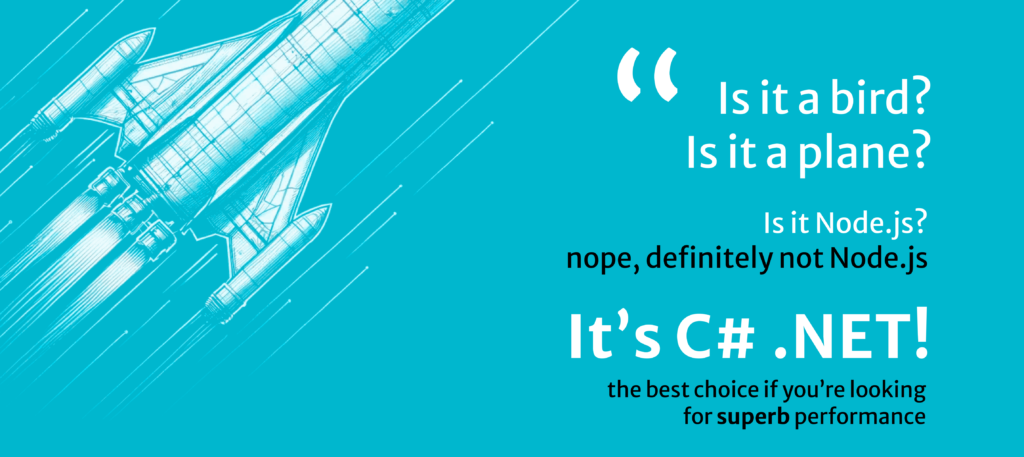
10. .NET is hard to learn, so it’s hard to find good .NET developers.| False!
This is a myth!
Although C# is a language with rich capabilities, its fundamentals are no more difficult to master than those of other popular programming languages. The introduction of .NET in version 6 brought about the feature of creating so-called minimal APIs, which enable developers to create full-fledged web APIs using just a few lines of code. This change has greatly simplified the programming process, making .NET more accessible, even for less experienced software engineers.
Additionally, thanks to Microsoft’s support, .NET has got rich technical documentation that is constantly updated and expanded, facilitating its learning. Equally important is the growing .NET user community, which actively shares its knowledge and experience, supporting other developers in learning and working with this framework.
What does this mean in practical terms? .NET has become easier to master. This is significant both for developers and when choosing the backend technology for your application. By selecting a framework that is popular, evolving, and easy to learn, you can be sure that, if needed, you will easily find specialists who know how to solve potential problems and where to look for information.
If you’re looking for .NET support in your project, a good solution might be to outsource this need beyond your organization. Thanks to expertise in .NET, mobitouch has been helping many industries for years by engaging our specialists in client projects.
11. .NET is one of the safest platforms. | True!
That’s a fact!
.NET was created with security in mind. The platform offers a range of features and tools that help in building secure and stable applications. One of the key aspects of the .NET security model is the support for Code Access Security (CAS), which allows developers to define detailed permissions for different types of code and resources. This helps prevent malicious code from accessing sensitive resources or performing unauthorized actions. Moreover, .NET provides built-in support for secure communication protocols, such as SSL and TLS, as well as strong encryption algorithms that help protect sensitive data. In addition, .NET offers a variety of tools and libraries for implementing secure coding practices, such as input validation and error handling, which can help prevent common security vulnerabilities. You can read more about .NET security here.
Conclusion
Myths debunked, facts confirmed. And this is just a drop in the ocean of positive news about C# .NET, a platform that is being dynamically developed and adapted to constantly growing programming and market expectations. Its versatility and the pace at which new improvements are added are impressive. No wonder why our developers love .NET.




